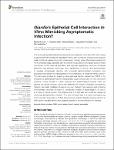Giardia's Epithelial Cell Interaction In Vitro: Mimicking Asymptomatic Infection?
Kraft, Martin R.
Klotz, Christian
Bücker, Roland
Schulzke, Jörg-Dieter
Aebischer, Toni
The protozoan parasite Giardia duodenalis is responsible for more than 280 million cases of gastrointestinal complaints (“giardiasis”) every year, worldwide. Infections are acquired orally, mostly via uptake of cysts in contaminated drinking water. After transformation into the trophozoite stage, parasites start to colonize the duodenum and upper jejunum where they attach to the intestinal epithelium and replicate vegetatively. Outcome of Giardia infections vary between individuals, from self-limiting to chronic, and asymptomatic to severely symptomatic infection, with unspecific gastrointestinal complaints. One proposed mechanism for pathogenesis is the breakdown of intestinal barrier function. This has been studied by analyzing trans-epithelial electric resistances (TEER) or by indicators of epithelial permeability using labeled sugar compounds in in vitro cell culture systems, mouse models or human biopsies and epidemiological studies. Here, we discuss the results obtained mainly with epithelial cell models to highlight contradictory findings. We relate published studies to our own findings that suggest a lack of barrier compromising activities of recent G. duodenalis isolates of assemblage A, B, and E in a Caco-2 model system. We propose that this epithelial cell model be viewed as mimicking asymptomatic infection. This view will likely lead to a more informative use of the model if emphasis is shifted from aiming to identify Giardia virulence factors to defining non-parasite factors that arguably appear to be more decisive for disease.
Dateien zu dieser Publikation
Keine Lizenzangabe

